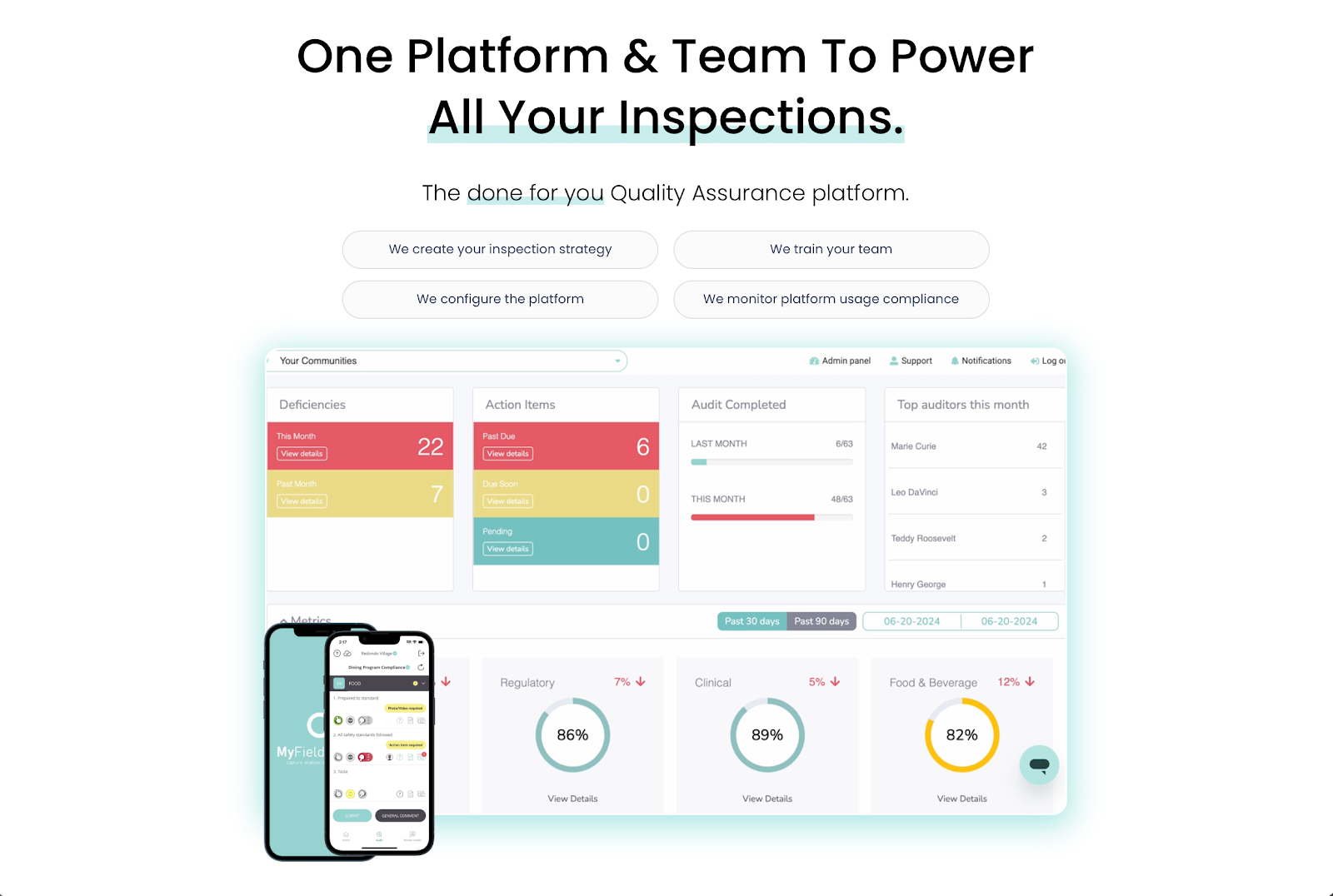.svg)
11 Restaurant Safety Procedures and Rules to Follow

Take Control of QA.
Make Inspections Effortless.

We’ll quickly uncover your needs and share how we can help—no pressure, no stress, just solutions. Grab your spot on our calendar today!
Be survey-ready every day with three simple dining audits

We’ll quickly uncover your needs and share how we can help—no pressure, no stress, just solutions. Grab your spot on our calendar today!
Restaurant safety involves more than handling food safely. It's also your responsibility to create a safe working environment for employees and protect customers from food contamination, allergies, and other potential hazards.
Poor safety practices can lead to foodborne illnesses, staff injuries, or failed restaurant inspections. These could directly impact your ability to operate your food service business in the long term.
Below, we'll share 11 restaurant safety tips that you can follow to ensure customer and employee safety. We'll also discuss why these safety procedures matter.
The Importance of Restaurant Safety Procedures
Implementing restaurant safety procedures is important for several reasons:
Comply With Regulatory Requirements
Any restaurant or food service operator should meet local and federal regulations to operate legally. Failing to comply with regulatory requirements can lead to legal liabilities, costly fines, or even operational shutdowns.
Restaurant safety procedures make it easier to pass HACCP audits, which prove the safety of the food served to customers. They also help you prepare for FSMA compliance audits through proactive food safety management.
Beyond food safety, you should also comply with OSHA rules by implementing restaurant safety standards. This shows that you prioritize workplace health and safety.
Prevent Foodborne Illnesses
Following strict rules for food storage, temperature control, and sanitation keeps your kitchen clean and your customers healthy. This can also prevent foodborne illnesses, which helps you avoid costly penalties and lawsuits.
Having restaurant safety procedures in place demonstrates your commitment to public health. They can build trust with customers and protect your company's reputation in the food service industry.
Protect Restaurant Workers From Accidents and Injuries
Slippery floors, hot equipment, fire hazards, and sharp tools are part of daily restaurant operations.
Without proper training and safety protocols, accidents and injuries are more likely to occur. For example, when a worker falls on a slippery surface, they might suffer from muscle strains or sprains.
Fortunately, implementing workplace safety procedures can ensure a safe environment for your employees. The simple act of adding a wet floor sign or using non-slip floor mats can prevent fall-related emergencies and protect employee health.
Improve Operational Efficiency
When everyone in your restaurant follows the same rules, operations run smoothly. You can focus on scaling locations while maintaining the same standardized procedures.
You no longer need to worry about equipment breakdowns or allergen management. Staff members know how to address common problems and meet customer expectations. This improves operational viability and boosts client satisfaction.
11 Restaurant Safety Procedures Every Food Service Company Should Follow
After learning the importance of restaurant safety procedures, you can start implementing these health and safety tips:
1. Establish a Regular Cleaning Schedule
A consistent cleaning routine can keep your kitchen safe, organized, and up to standard.
Use a restaurant audit checklist to schedule cleaning tasks and ensure nothing important is missed. Common tasks include sanitizing high-touch surfaces, sweeping floors, disinfecting food preparation areas, and wiping dining chairs and tables.
Always check behind kitchen equipment and other hard-to-see spots where grease and debris build up. You should also clean spills immediately to prevent slips, ensure safety, and avoid bad smells.
Posting the cleaning schedule and doing random checks can keep everyone accountable and your kitchen inspection-ready.
2. Label and Store Food Correctly
Improper food storage is one of the leading causes of health violations.
Label all food items with preparation dates, ingredient lists, and expiration dates. You can also use color-coded containers. Store raw meats away from ready-to-eat foods to prevent cross-contamination.
Then, check if freezers, refrigerators, and dry storage areas have the proper temperatures. You also want to keep items organized and properly sealed to avoid food safety risks.
3. Enforce Proper Handwashing Techniques
Washing hands might seem basic, but it’s one of the most effective ways to prevent food contamination in any restaurant or commercial property.
Set up handwashing stations with soap, warm water, and disposable towels in every work area. Display signs to remind workers of when and how to wash their hands, such as before food handling, after using the restroom, or after touching garbage.
Don’t rely on gloves alone. You should train employees to treat handwashing as a routine. Hold everyone to the same standard, and conduct spot checks during shifts to reinforce the habit, especially among new hires.
4. Use Separate Food Prep Areas
Using different stations for meats and produce reduces the risk of cross-contamination. Invest in separate cutting boards and utensils for each type of ingredient and label them clearly.
Training staff on how to wipe down stations between tasks and use color-coded tools can significantly enhance food safety.
You should also avoid close contact with allergens when serving food to customers with allergies and dietary restrictions. Make sure employees know how to handle food allergies through regular food safety education.
5. Cook Food at Safe Temperatures
Food should reach a safe internal temperature to kill harmful bacteria. Use thermometers to confirm proper cooking levels for meat, poultry, seafood, and leftovers.
Keep a reference chart in the kitchen, so employees are always aware of the required minimum safe temperatures.
You should also regularly check holding temperatures on serving areas, steam tables, and warming trays. Undercooked food can lead to serious illness and liability.
6. Handle and Maintain Equipment Safely
Your kitchen runs on machines, such as fryers, fridges, slicers, mixers, and grills. If these unexpectedly break or are misused, your employees might get hurt.
Inspect all cooking equipment regularly for loose cords, worn parts, or unusual sounds. Replace faulty tools right away. Never let staff use damaged or unfamiliar equipment without the employer's supervision.
You should also put up instructions for proper equipment handling. Then, assign maintenance checks to a manager or the lead cook using inspection scheduling software. This protects your kitchen staff.
7. Require Protective Attire
Employees should never enter your establishment without the right protective equipment.
Advise all staff members to wear non-slip shoes to protect themselves against spills and broken glass on the floor.
You should also require them to use aprons, gloves, and hairnets to ensure safe food handling. If they are working near fryers or ovens, make sure they're wearing burn-resistant sleeves or mitts.
Onboarding should cover what attire is required and when. Offering uniform stipends or replacements also helps ensure compliance with these restaurant safety procedures.
8. Control Pests Through Preventive Measures
Rodents, flies, and roaches carry disease and affect food safety. Pest issues spread fast and can lead to forced business closures.
Don’t wait for an outbreak. Instead, take a proactive approach to pest control.
Prevention starts with clean, sealed storage spaces and frequent trash disposal. Keep doors and windows closed or fitted with screens.
Place traps in non-food areas and log each check. You can also train employees to report droppings or signs of pest activity immediately.
Better yet, schedule regular visits with a licensed pest control provider to ensure food safety compliance.
9. Conduct Regular Fire Drills and Ensure Working Fire Safety Equipment
Routine fire drills prepare your team to respond quickly to fire emergencies. Every employee should know where to find and how to use extinguishers and fire blankets. Keep exit routes clear and marked for a faster escape.
You should also install suppression systems above fryers and stoves. Then, test alarms and service systems on schedule to ensure they're in proper working condition.
Include these tasks in your facility inspection checklist to avoid missing something important.
10. Provide Staff Training
You can’t expect employees to follow restaurant safety procedures they don’t understand.
Offer training for both new hires and current team members. Cover handwashing, food handling, equipment use, and emergency protocols.
Role-specific training helps reduce repetitive motions that cause strain, especially for prep cooks and dishwashers. Use videos, demonstrations, and checklists for better retention.
Make training part of regular staff meetings to improve accountability and build a stronger safety culture.
11. Document Safety Procedures and Incidents
Consistent record-keeping practices help you track safety problems and prove compliance.
Create a log for cleaning schedules, temperature checks, staff training, pest control, and accidents. Use a binder or digital system to keep everything in one place.
If a health inspector or insurance provider asks for documentation, you’ll be ready. You can also spot repeat issues before they become major problems. More importantly, it's easier to maintain the same standards across various locations and avoid negative consequences.
Ensure Consistent Safety Procedures With MyFieldAudits
Maintaining safety standards across multiple restaurant locations is no easy task. MyFieldAudits understands this, so they provide access to an easy-to-use inspection platform.
Their mobile-friendly app helps you standardize operations from the kitchen to the front of the house.

What sets MyFieldAudits apart is its done-for-you approach to quality assurance and safety. On top of developing a powerful software solution, they act as a retention engine for enterprise clients.
Industry experts will help you develop custom inspection strategies that address unique operational challenges. They will also take care of staff training, platform configuration, and compliance monitoring.
This allows you to focus on keeping operations safe, efficient, and compliant.
Schedule a discovery call today! You can also watch this video to learn how MyFieldAudits can benefit your food service management business.
FAQs About Restaurant Safety Procedures
What are the five food safety procedures?
The five basic food safety procedures are to clean all surfaces regularly, keep raw and cooked foods separate, store food at safe temperatures and in dry places, cook to the right internal temperature, and use safe raw resources.
What is the 30/30/30/10 rule for restaurants?
The 30/30/30/10 rule is a financial guideline that helps restaurant owners divide their revenue into four categories to increase profitability and control costs.
You should allocate 30% to food ingredients, 30% to labor, and 30% to overhead expenses. The remaining 10% is the total profit, which can be reinvested after covering all costs.
What are the ten basic safety rules?
Common safety rules in restaurants include cleaning all areas thoroughly, labeling food, washing hands properly, avoiding cross-contamination, maintaining equipment, wearing protective attire, reporting hazards, keeping emergency exits clear, and sealing trash cans.
These rules create a safer community, prevent foodborne illnesses, maintain your restaurant's good standing, and ensure long-term operational viability.
What are the seven-step safety rules?
In food safety, the seven-step rules help restaurants keep food safe from contamination. These include the following guidelines:
- Identify potential hazards.
- Find critical control points.
- Set safe limits.
- Monitor food temperatures.
- Implement corrective actions if limits are not met.
- Verify that food safety procedures work.
- Maintain complete and accurate records
%201.svg)






%201%20(1).svg)